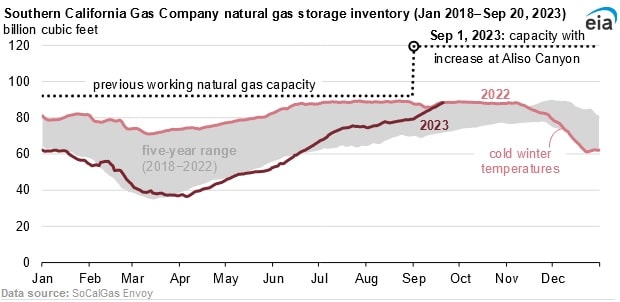California’s Aliso Canyon Natural Gas Storage Increased by 67 Percent to Enhance Winter Reliability: EIA

Total working gas storage at Southern California Gas Company’s Aliso Canyon Natural Gas Storage Facility has been increased by 67 percent, in order to prevent potential rises in energy prices and support reliability during the upcoming winter 2023-24, according to a Sept. 27 report from the U.S. Energy Information Administration. The California Public Utilities Commission voted in August to approve the expansion, increasing the company’s total working gas storage to about 120 billion cubic feet (Bcf).
Last winter, several weeks of below seasonal normal temperatures on the West Coast, led to higher gas demand for heating and accordingly storage sites withdrew large volumes from gas. Accordingly, storage sites ended the season with 30 percent less gas than the previous five year average. High gas storage levels lead to lower price volatility during the winter months, since higher demand due to below seasonal normal temperatures, can be fulfilled with demand withdrawn from storage, rather than the market having to rely on higher price imports or higher priced energy sources to satisfy domestic demand. Low gas storage levels during December 2022, led natural gas prices at the SoCal Citygate pricing hub to trade with volatility between $20 and $50 per million British thermal units.
Without the regulatory cap, Aliso Canyon has a total working natural gas storage capacity of 86.2 billion cubic feet, and accounts for 63 percent of Southern California Gas Company’s total. The Aliso Canyon has been working at reduced capacity since 2017, on the back of a well leak in 2015 and thereafter the repair in 2016. The CPUC has amended the Aliso Canyon storage facility’s capacity a number of times, in reaction to changing market conditions.
As of Aug. 31, gas storage in the Southern California Gas Company’s system is around 88 percent full, with 79.2 Bcf of working natural gas, when the previous 41.2 Bcf cap at Aliso Canyon was in place. The commission’s approval is providing an additional 23 percent of capacity as of Sept. 1.
The commission is in the process of investigating the feasibility of minimizing or eliminating the use of the Aliso Canyon natural gas storage facility, which came under scrutiny following a four-month gas leak from a disastrous blowout in October 2015 that resulted in the estimated release of 4.62 billion cubic feet of natural gas. In September 2022, the commission released a staff proposal to create a framework to replace the facility as regulators explore a solution to substitute the gas facility by using non-gas-fired electricity generation, storage energy efficiency, and building electrification.
EnerKnol Pulses like this one are powered by the EnerKnol Platform—the first comprehensive database for real-time energy policy tracking. Sign up for a free trial below for access to key regulatory data and deep industry insights across the energy spectrum.
ACCESS FREE TRIAL